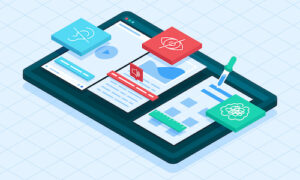Key points:
- More accessible content improves daily life for the nearly 1 in 4 adults living with a disability
- Acknowledging and addressing the varied needs of learners and instructors is critical
The completion of the academic year offers educators a unique opportunity for introspection, evaluation, and strategizing. Equipped with the insights from recent student feedback, instructors are well positioned to reflect on the successes of the term, as well as identify areas where more could be done to elevate the students’ learning experience. One such area for assessment is often the accessibility aspects of their course content.
Nearly one in four U.S. adults lives with a disability, highlighting the need for more accessible content. The concept of accessibility has evolved significantly over the last decade. In today’s educational landscape, it is essential, both ethically and legally, to ensure that individuals with disabilities have equal access to digital content, in alignment with the Section 508 Standards and the Americans with Disabilities Act (ADA).
Navigating the Landscape of Accessibility
Within higher education, acknowledging and addressing the varied needs of the learners and instructors is paramount. A one-size-fits-all approach may inadvertently overlook some learners, given the unique set of needs and shifting priorities of each student. By proactively recognizing and addressing these diverse needs, educators can stimulate greater participation, foster deeper engagement, and enhance learning outcomes.
As universities increasingly welcome non-traditional learners, the demographics within classrooms are undergoing a significant transformation. Today’s educators are tasked with teaching a diverse group of students, including working parents, busy professionals, and individuals contending with various challenges, from chronic health conditions to technological constraints.
The recognition that disability status can shift unpredictably emphasizes the necessity of developing universally accessible courses. These courses, adaptable to a broad spectrum of student needs, showcase their indispensable role in the educational setting.
Optimizing Accessibility in Education: A Four-Pronged Approach
To foster an inclusive learning environment, it’s paramount that educators incorporate accessibility in their course design. Here are four ways to enhance accessibility, thereby making learning experiences more engaging and beneficial for all students.
1. Boost Accessibility Through Alternative Text for Images
Providing alternative text for images is a significant enhancement in accessibility because it allows for broader interaction with the content, primarily through the ability for students to search by image and expand the reach of educational resources. This strategy holds particular significance for students facing unstable internet connections or those dependent on assistive technology, marking it a crucial component of an inclusive course design.
2. Improve Navigation with Document Headings
By employing the headings feature in applications like Microsoft Word or Google Docs, accessibility can be considerably improved. Owing to its unique underlying coding, this feature aids students in effortlessly navigating through extensive documents. For those using assistive technology, it provides the convenience of transitioning from one heading to another, substantially simplifying the reading process.
3. Promote Visibility via Color Contrast
Tools such as Color Safe can be harnessed to help learners better distinguish the text color from the background colors. Color contrast assists those with low vision, reduces the impact of glare, and enhances readability across a spectrum of devices, including older monitors. This strategy is a subtle but critical stride toward creating a truly comprehensive digital learning environment.
4. Prioritize Digitized Materials Over Scanned PDFs
While converting materials into PDFs through scanning might seem convenient, these documents often present significant accessibility challenges. Due to their limited capabilities and the difficult of getting a high-quality scan, they can be problematic to read, especially with assistive technology. Hence, educators should prioritize using digitized versions and phasing out any scanned PDFs. This strategic decision greatly improves content accessibility, promoting better engagement with course materials for all students.
By implementing these four measures, educators can make substantial progress toward creating an accessible learning environment, enabling every student to reach their full academic potential. Accessibility checkers can streamline the process, identifying potential issues and providing guidance for instructors on how to correct them while creating alternative formats like audio or mobile-friendly files automatically that align to learners’ needs.
Broadening the Perspective on Accessibility
Rather than viewing accessibility as a concern for a specific group of students, it warrants a broader perspective. The digital world offers a parallel. Text-to-speech applications, initially created for individuals with low vision, have found utility among those with perfect vision, saving time and enhancing safety. By proactively designing courses to be accessible to a broader audience, not only can students with disabilities more easily access content, but it also enables a greater number of students to engage with, and even become passionate about, the material.
By incorporating accessible design elements into our courses, we can foster a more inclusive learning environment, benefiting all students and paving the way toward a more vibrant, equitable educational landscape.
Related:
Inclusive education programs offer support for students with intellectual disabilities
- The link between AI fluency and the next education revolution - May 3, 2024
- Coalition looks to accelerate LER adoption in higher ed - May 1, 2024
- Selective universities won’t be disrupted - April 30, 2024

